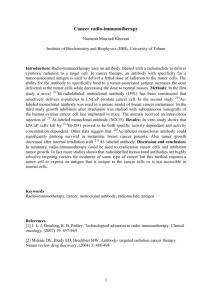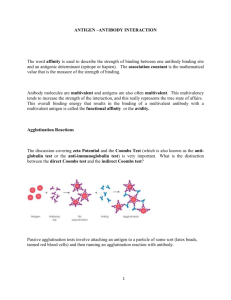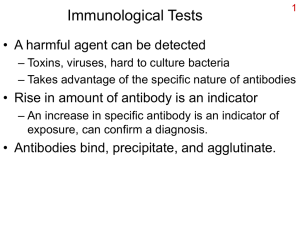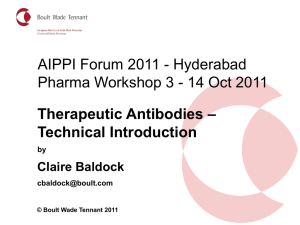F4_-_Immunological_tests
advertisement
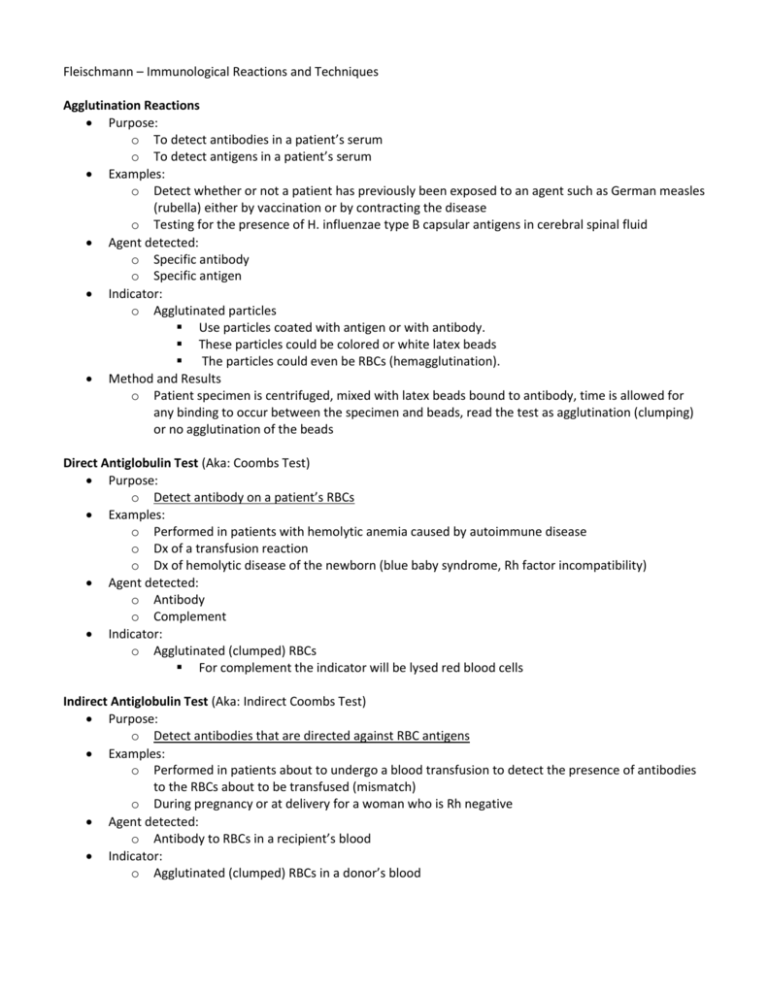
Fleischmann – Immunological Reactions and Techniques Agglutination Reactions Purpose: o To detect antibodies in a patient’s serum o To detect antigens in a patient’s serum Examples: o Detect whether or not a patient has previously been exposed to an agent such as German measles (rubella) either by vaccination or by contracting the disease o Testing for the presence of H. influenzae type B capsular antigens in cerebral spinal fluid Agent detected: o Specific antibody o Specific antigen Indicator: o Agglutinated particles Use particles coated with antigen or with antibody. These particles could be colored or white latex beads The particles could even be RBCs (hemagglutination). Method and Results o Patient specimen is centrifuged, mixed with latex beads bound to antibody, time is allowed for any binding to occur between the specimen and beads, read the test as agglutination (clumping) or no agglutination of the beads Direct Antiglobulin Test (Aka: Coombs Test) Purpose: o Detect antibody on a patient’s RBCs Examples: o Performed in patients with hemolytic anemia caused by autoimmune disease o Dx of a transfusion reaction o Dx of hemolytic disease of the newborn (blue baby syndrome, Rh factor incompatibility) Agent detected: o Antibody o Complement Indicator: o Agglutinated (clumped) RBCs For complement the indicator will be lysed red blood cells Indirect Antiglobulin Test (Aka: Indirect Coombs Test) Purpose: o Detect antibodies that are directed against RBC antigens Examples: o Performed in patients about to undergo a blood transfusion to detect the presence of antibodies to the RBCs about to be transfused (mismatch) o During pregnancy or at delivery for a woman who is Rh negative Agent detected: o Antibody to RBCs in a recipient’s blood Indicator: o Agglutinated (clumped) RBCs in a donor’s blood Electrophoresis Purpose: o To detect the levels of various proteins Can be used to check for immune deficiencies Examples: o Detect monoclonal IgG produced by myeloma patients o Measuring amount of albumin and other blood constituents o Detect immune deficiencies Agent detected: o Antibody o Antigen o Any protein Indicator: o Visible band of agent on a gel o Stained band of an agent on a gel Coomassie blue or silver stain for protein Use stain when there is not enough to see with the naked eye Ethidium bromide for nucleic acid Method o Prepare a polyacrylamide or agarose gel o Load sample on the gel o Apply an electric current across the gel for a period of time o Visualize the band on the gel With the naked eye By exposure of the band to UV-light By staining the band with a dye. o Quantify the amount of material in the band by densitometer reading Multiple Myeloma Antibodies are produced by B cells and plasma cells. When a single plasma cell becomes transformed into a cancerous cell, it causes myeloma. o Myeloma patients over-produce a homogeneous Ig produced by a single plasma cell. This can be observed as a heightened peak of Ig by electrophoresis of blood proteins. o Myeloma patients also have some immunoglobulin proteins that spill over into their urine. These Bence-Jones proteins are dimers of kappa or lambda light chains. Immunofixation Purpose: o Identification of composition of monoclonal antibody Examples: o Detection of monoclonal antibody type in myeloma patients (plasma cell lymphoma giving an overproduction of IgG, IgA, IgE) o Detection of monoclonal antibody in Waldenstom’s macroglobulinemia (B cell lymphoma giving an overproduction of IgM) Agent detected: o Specific heavy and light chain of monoclonal antibody Indicator: o Antibody against heavy and light chains Immunofluorescence Purpose: o Detection of an antigen in a specimen Examples: o Detection of specific proteins in cells, such as a tumor antigen or a viral antigen o Detection of bacterial organisms o Detection of antigen-antibody complexes that have been deposited on cell membranes or BM surfaces Agent detected: o Antigen that is precipitated on a cell o Antigen that is part of the cell membrane o Agent that is within the cell (must permeablize the cell) Indicator: o Antibody that has a fluorescent tag Method o Direct Fix cells to a slide Add antibody (IgG) specific to the target antigen that is tagged with fluorescent compound Visualize fluorescence by looking through a fluorescence microscope o Indirect Fix cells to a slide Add primary antibody (IgG) specific to the target antigen Add secondary anti-antibody (anti-IgG) that is tagged with fluorescent compound Visualize fluorescence Enzyme-Linked Immunosorbent Assay (ELISA) Purpose: o Detection of antibodies or antigens in a patient specimen Examples: o Home pregnancy test o Detection of antibody to a virus, bacterium or other microorganism HIV test o Detection of antibody to a foreign antigen o Detection of a viral antigen or bacterial antigen Kinds of ELISA o Indirect ELISA (start with antigen, add primary Ab, then fluorescent secondary Ab) o Sandwich ELISA (start with Ab, add antigen, then fluorescent secondary Ab) o Radioimmunoassay Agent detected: o Antibody o Antigen Indicator: o Antibody with a bound enzyme that can catalyze conversion of a colorless molecule to a colored one Alkaline phosphatase Horseradish peroxidase o Antibody with a bound radioisotope Elispot (This is a variation of the ELISA test) A petri plate is coated with specific capture antibody. Cells are added to the plate and allowed to settle for a period of time. Cells produce a specific cytokine that binds to the specific antibody in the area where the cell settled. The cells are washed away. Detection antibody bearing an enzyme is added and unbound excess antibody is washed away. An appropriate substrate is added. An area of the petri plate where the cytokine was produced turns color. Western Blot Purpose: o Detection of antibodies or proteins in a patient specimen Examples: o Detection of antibodies to HIV in a patient’s blood o Detection of HIV proteins in a patient’s blood Agent detected: o Antibody o Antigen Indicator: o Antibody tagged with fluorescent molecule o Antibody tagged with enzyme to convert clear compound to a colored compound o Antibody tagged with chemiluminescence enzyme (luciferase) o Antibody tagged with radiolabel Detection of HIV Western blot is the confirming test Detects antibodies to various protein components of HIV o Tests multiple antibodies to eliminate the possibility of cross reactivity (false positive) Color change or radioactivity indicates positive result Flow Cytometry Purpose: o Determine the number or percentage of cells that express a given antigen Examples: o Monitoring CD4+ T cell levels in HIV-infected patients o Diagnosis of leukemia and lymphoma Agent detected o Cells bearing a specific antigen Indicator o Antibody tagged with fluorescent molecule
